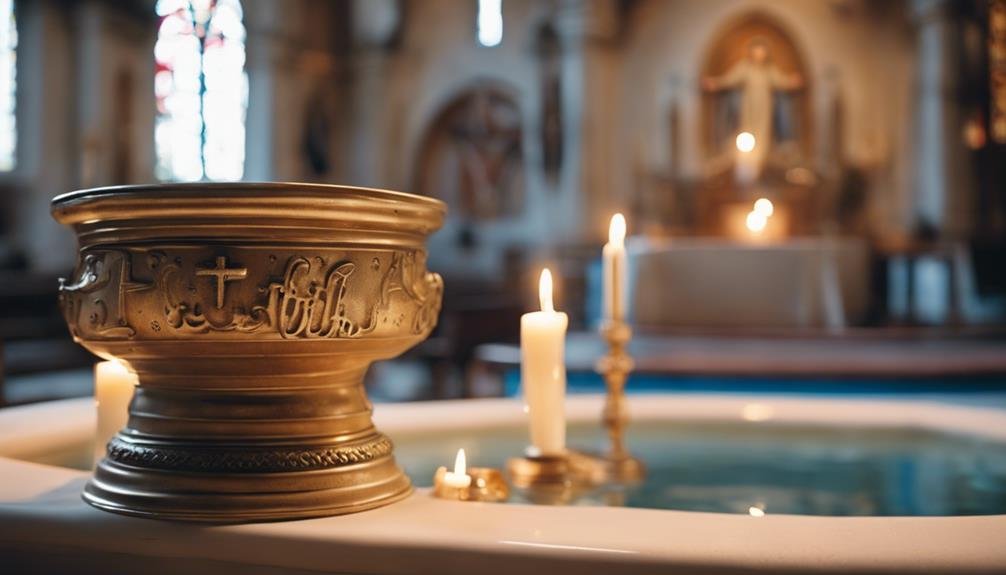When considering the differences between Christening vs Baptism, you might wonder how these ceremonies distinguish themselves within the Christian faith. Christening usually centers around naming a child and introducing them to the faith community, while baptism is about cleansing sins and spiritual rebirth. Though sometimes overlapping, both rituals have unique roles and significance.
So, why do some traditions emphasize one over the other, and what historical contexts shaped these practices? Understanding these elements may offer deeper insights into their importance within various Christian denominations.
Key Takeaways
- Christening names and formally introduces a child to the Christian community, while baptism symbolizes spiritual cleansing and initiation into the faith.
- Christening typically occurs during infancy, whereas baptism can be performed at any age, depending on denominational practices.
- Baptism, a sacrament in many traditions, involves the symbolic cleansing of sins, while christening focuses on the public declaration of a Christian name.
- Christening is commonly associated with Anglican, Lutheran, and Methodist churches; baptism is prevalent in Catholic, Eastern Orthodox, and Protestant denominations.
- Cultural variations influence the method of water application and the terminology used, with some regions using ‘christening’ and ‘baptism’ interchangeably.
Definitions

When defining christening and baptism, it’s important to grasp that they serve different purposes within the Christian faith. Christening is primarily a naming ceremony where a child is given their Christian name.
This event often precedes baptism and can include it, but the main focus of a christening is to formally introduce the child to the community with their new Christian identity.
On the other hand, baptism is a religious sacrament that symbolizes the cleansing of original sin and rebirth into the Christian faith. During this ritual, water is used in the name of the Father, the Son, and the Holy Spirit, marking the individual’s official entry into the Christian community.
While christenings often feature godparents who are baptized church members, their role is to support the child’s spiritual journey. Baptisms, however, aren’t always part of a christening ceremony.
The key distinction lies in their purposes: christenings focus on naming and identity, whereas baptisms emphasize spiritual cleansing and initiation.
Understanding these differences ensures you can appreciate the unique roles each plays within Christian traditions. Both ceremonies hold significant value but cater to different aspects of a person’s spiritual and communal life.
Historical Background
Understanding the historical background of christening and baptism offers deeper insights into their distinct roles within the Christian faith. While these practices are often used interchangeably, they have unique origins and evolving meanings.
- Baptism dates back to Jesus Christ: Baptism has its roots in the time of Jesus Christ, who was baptized by John the Baptist in the Jordan River. This act is recorded in the Bible and signifies the importance of baptism in Christian tradition.
- Early Christian practice: Early Christians followed Jesus’ command to baptize believers in the name of the Father, Son, and Holy Spirit. This practice symbolized spiritual cleansing and rebirth, making it one of seven sacraments in many Christian denominations.
- Origin of the term ‘Baptism’: ‘Baptism’ comes from the Greek word ‘baptizō,’ meaning to immerse or dip. This reflects the act of water immersion that’s central to the sacrament.
- Christening refers to naming: Christening evolved as a term used mainly for infants receiving their Christian name during the baptism ceremony. The term christening highlights the naming ceremony (to christen) aspect, which differentiates it slightly from the broader practice of baptism.
Understanding these points helps clarify the historical background and significance of both practices.
Ceremonial Differences

Ceremonial differences between christening and baptism highlight each practice’s unique aspects and purposes within the Christian faith. In a christening, a child is given their Christian name before their church, family, and friends.
This ceremony, to christen, means to name, and it often marks the child’s formal introduction to the Christian community. Christian families gather to witness and celebrate this important milestone.
On the other hand, baptism is a more symbolic act. During a baptism, a minister splashes or immerses someone in water. This act represents the cleansing of their sins and their rebirth as Christians.
Baptism comes from the Greek word ‘baptizō,’ meaning to dip, immerse, or wash. Unlike a christening, baptism focuses more on spiritual initiation and purification. Understanding that many christenings include a baptism but aren’t always synonymous is essential.
While a christening names a child in the name of the Father, the Son, and the Holy Spirit, a baptism formally initiates an individual into the church. Though sometimes overlapping, these ceremonies serve distinct roles in Christian families’ faith journey.
Symbolism and Significance
While the ceremonial differences set christening and baptism apart, their symbolism and significance deeply intertwine within the Christian faith. Both rituals are foundational acts that affirm one’s place within the religious community and reflect core Christian beliefs.
- Baptism: This sacrament symbolizes the washing away of sins. Whether through immersion or sprinkling, water signifies purification and rebirth. As one of the sacraments in the Catholic Church, baptism marks the individual’s official entry into the Christian faith.
- Christening: Often performed alongside or before baptism, christening refers to naming the child within a religious context. It’s a moment where the family publicly declares the child’s Christian name, signifying their inclusion in the faith community.
- Family Involvement: Both ceremonies emphasize family and community. By participating in these rituals, families express their readiness to nurture the child’s spiritual journey and uphold Christian values.
- Spiritual Identity: Both baptism and christening carry the symbolic significance of acknowledging one’s faith and identity. Individuals and their families commit to living by Christian teachings and traditions through these acts.
Age and Timing

The timing of baptism or christening can vary widely, influenced by denominational practices and personal beliefs. In many Christian churches, especially those practicing christening, infants are typically the recipients.
This practice usually involves the sprinkling of water and serves as a naming ceremony, where parents accept the responsibility of raising their child in the faith. However, baptism isn’t restricted to infants. In some denominations, it can occur at any age.
These churches often believe individuals should be old enough to profess their faith before baptism. This means baptism might be given to children, teenagers, or adults who embrace Christianity later in life.
The decision about when to baptize or christen a child often depends on the specific teachings of your church and your personal beliefs. Some parents prefer to have their children christened as infants, while others wait until their child is old enough to understand and make the decision themselves.
Both practices hold significant meaning, reflecting the diverse ways Christian churches interpret and celebrate the initiation into the faith. Given these variations, understanding your church’s beliefs will guide you in choosing the right timing.
Cultural Variations
In various cultures, christening is often a formal naming ceremony for infants, while baptism is viewed as a deeper religious initiation. This distinction can be significant depending on the cultural and spiritual context.
Understanding these differences is essential when planning such ceremonies. Here’s a closer look at how cultural variations play a role:
- Naming vs. Spiritual Significance: In many traditions, christening means to give a name to the child, focusing on their identity within the community. On the other hand, baptism is one of the sacraments that symbolizes spiritual rebirth and the washing away of sins.
- Regional Preferences: Some regions may prefer christening as the primary ceremony for infants, while others emphasize baptism. This preference reflects deeply rooted societal and religious beliefs.
- Terminology Usage: In some cultures, christening and baptism are used interchangeably, leading to confusion. However, the ceremonial aspects and significance can vary greatly.
- Ceremonial Practices: Cultural nuances dictate whether infants are sprinkled with water during christening or fully immersed in baptism. Each method carries its symbolic meaning and tradition.
Conclusion
Essentially, understanding christening and baptism helps you appreciate their unique roles. While christening introduces a child to the Christian community, baptism symbolizes spiritual cleansing and rebirth.
Both ceremonies have rich histories, distinct rituals, and profound symbolism. Recognizing these differences allows you to see how each contributes uniquely to a person’s spiritual journey. Whether planning one or attending one, you’ll now have a deeper insight into its significance and timing.

